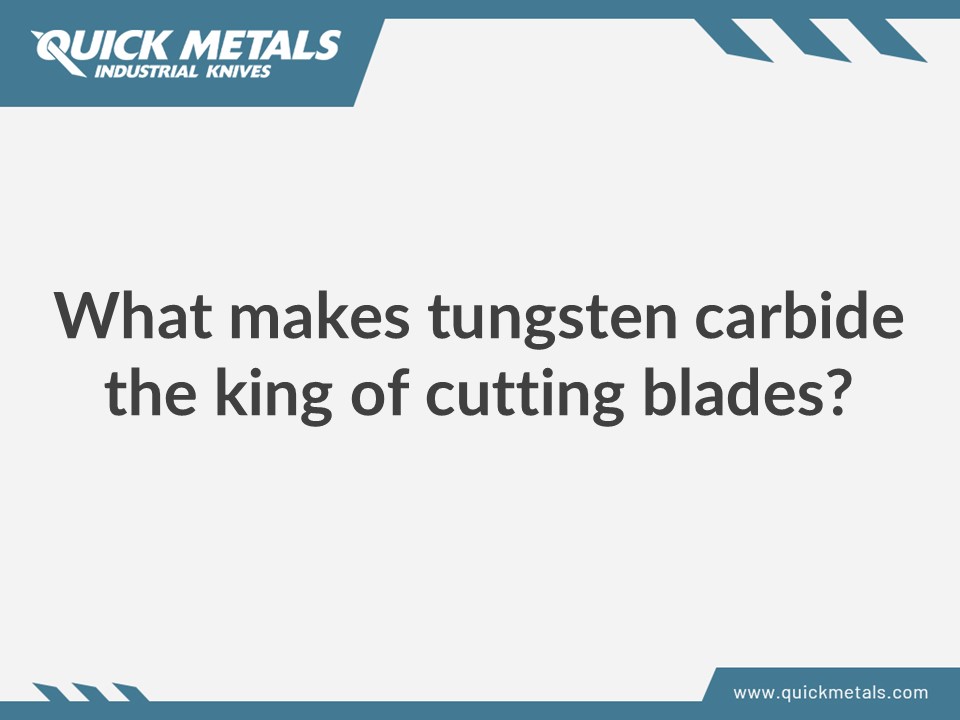What makes tungsten carbide the king of cutting blades? - PowerPoint PPT Presentation
Title:
What makes tungsten carbide the king of cutting blades?
Description:
Why is tungsten carbide the king of cutting blades? Learn about its unmatched toughness, wear resistance, and performance in high-demand cutting environments. – PowerPoint PPT presentation
Number of Views:0
Title: What makes tungsten carbide the king of cutting blades?
1
What makes tungsten carbide the king of cutting
blades?
2
- Tungsten carbide blades have revolutionized
precision cutting in the world. Its unmatched
performance is observed and experienced in almost
every industry. This blade, made primarily of
tungsten carbide particles bonded in a metal
matrix, marked a high water mark in modern
technology balancing extreme hardness against
tremendous toughness. - Tungsten carbide traces its origin to the early
20th century when researchers searched for
something harder than steel. A revolution in
cutting technology began in 1923 with the
introduction of the first tungsten carbide
cutting tools. As carbide has improved in
composition as well as manufacturing processes,
we have come to use these high-performance blades.
3
- Properties of tungsten carbide blades
- Hardness and toughness Blades containing
tungsten carbide are extremely hard, up to 9.5 on
the Mohs scale when compared to diamond at 10.
The hardness is directly associated with good
abrasion resistance so that blades do not lose
their cutting edge for as long as any ordinary
steel blade could, a scenario where change is
made less frequently in production, idle time is
reduced, and productivity is increased in
industries. - Thermal conductivity Although much less
thermally conductive than many metals, tungsten
carbides thermal properties are very suitable in
cutting applications. Its moderate thermal
conductivity helps to dissipate heat generated
during the cutting process, avoiding overheating
of the blade, as well as of the material
undergoing cuts. This characteristic is
especially important at higher-speed cutting
operations where the buildup of heat can be a
problem.
4
- Chemical resistance Tungsten carbide is
resistant to most chemicals and corrosive
materials. It is made of this material because it
can be used under harsh environments or when
cutting materials that can react to, or corrode,
other blade materials. Acidic woods, corrosive
metals and many other materials- its blades
maintain their integrity and performance. - Edge retention The most coveted attribute of
tungsten carbide knives is edge retention. The
balance between hardness and toughness allows the
knife to retain a sharp cutting edge that could
easily last much longer than the conventional
blades. This leads to a generally more consistent
cut, lessening the need to resharpen repeatedly
or replace several times.
5
- Applications in various industries
- Metalworking and machining Tungsten carbide
blades are versatile, as there is a broad
application in metalworking while using hard
metals, alloys, or abrasive materials. They can
be used in milling, turning, and drilling with
accuracy and longevity at very high manufacturing
standards. - Woodworking and forestry Tungsten carbide-tipped
saw blades and cutting tools are used in forestry
and woodworking industries as they can easily cut
through knots, resinous woods, and even wood with
small metal objects without blunting as fast as
traditional blades. - Plastics and composites processing Bay Plastics
has adopted tungsten carbide blades for its
cutting operations. They provide superior
performance in cutting and shaping plastics and
composites without melting or deforming the
material, enabling the manufacture of
high-quality plastic components.
6
- Food processing and packaging Tungsten carbide
blades cut sharper and resist wear longer in
continuous cutting of abrasive or frozen foods,
in addition to resisting chemicals and holding up
to situations where frequent cleaning or
sanitizing is required. - Medical and surgical instruments Tungsten
carbide is used in the medical field due to its
accuracy and hardness in the production of
surgical instruments and other medical equipment.
Its blades, ranging from scalpels and bone saw
blades, possess sharpness and dependability
majorly needful in medical procedures. - Specialized tungsten carbide blades
- Gala die cutting solutions Gala Die is the
leader in specialized tungsten carbide blades for
the die cutting industry.
7
- Gala Die blades provide clean, accurate cuts on
everything from a few microns to thick rubbers
with an emphasis on tailored solutions to fulfill
the special needs of each client. This means
manufacturers can fine-tune their cutting process
to meet the particular requirements of certain
materials and applications. - Maags precision cutting technology Maags
tungsten carbide blade technology is engineered
at a high level, targeting large volumes with
excellent cut quality, for the production of
plastics and polymer industries. It specifically
deals with pelletizing and granulating processes.
Its innovations in geometric blade formations and
matter presence have led to standards for
pelletizing and granulating processes. - Custom-designed blades for specific applications
As the usage of tungsten carbide is very
flexible, it allows manufacturers to make highly
specialized blades for various unique cutting
tasks. Working closely with blade producers can
lead to highly specific blades for intricate
die-cutting jobs to complex multi-edge blades for
highly complex cutting operations that require
multiple cuts.
8
- Conclusion
- Tungsten carbide blades come with a lot of
advantages in cutting technology, with hardness,
resistance to wear, and flexibility similar to
that offered by traditional materials. Their
reputation of holding an edge for a long time
coupled with an ability to withstand severe
environments make them highly valued in a wide
range of industries. - From medical instruments that need to be accurate
to forestry equipment that must be durable,
tungsten carbide blades seem to push the barriers
of what is possible with other cutting
technologies. In the future, tungsten carbide
blades will play a more important role in
precision cutting as manufacturing processes
change and new materials and applications emerge,
thus promoting further innovation and efficiency.
9
(No Transcript)































